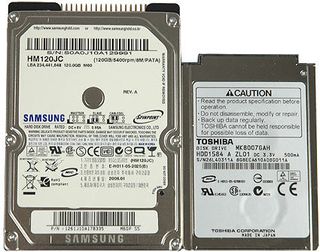1.8" Hard Drives: Small is Beautiful
Conclusion

Both the Hitachi and the Toshiba drives are suitable for ultraportable PC solutions. Their storage capacity is adequate, and the performance levels are capable of meeting the requirements of both office applications and basic multimedia programs. Some ultraportable notebooks - such as the Dell X1 and Samsung's Q30 - are already based on 1.8" hard drives, and we expect more to come. Toshiba offers better performance, but Hitachi counters with better energy efficiency and lower weight.
However, we need to make one thing unmistakably clear: the hard drive is still the main performance bottleneck in many application scenarios, and on all existing PC types. Whether you start Windows, launch applications or flip through large digital photos, you will always experience a delay due to the hard drive. The slower your hard drive is, the more noticeable the delay will be. Neither the fastest processor nor ridiculous amounts of RAM can change this fundamental equation.
Two issues turn this bottleneck into a real pain with small drives. First, the small platter diameter of 1.8" hard drives makes for low absolute rotation speeds. Second, the spindle speed of 4,200 RPM is already comparably slow: desktop hard drives spin at 7,200 RPM or more, and even 2.5" notebook drives are moving in this direction. Still, with energy requirements being a top priority in 1.8" product development, future products will probably not spin at faster speeds any time soon.
The bottom line is that there is an essential tradeoff between performance and physical characteristics. If you want an ultraportable PC using a 1.8" drive, you will forfeit performance. There is nothing that can change this right now, but ultraportable notebooks, UMPCs and smallest-form-factor solutions will lose their 1.8" drive handicaps in the near future. Windows Vista will support hybrid hard drives that come with a complement of 2 GB or more of Flash memory; this can be best considered like a huge, non-volatile cache. System data and frequently accessed files will be stored on the Flash part of a hybrid hard drive to minimize mechanical hard drive activity. Unfortunately, we will have to wait to reap the benefits of these drives, both for Windows Vista, and the availability of the drives themselves.
Join our discussion on this topic
Stay on the Cutting Edge
Join the experts who read Tom's Hardware for the inside track on enthusiast PC tech news — and have for over 25 years. We'll send breaking news and in-depth reviews of CPUs, GPUs, AI, maker hardware and more straight to your inbox.
Most Popular

